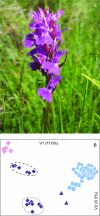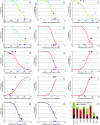Stable epigenetic effects impact adaptation in allopolyploid orchids (Dactylorhiza: Orchidaceae)
- PMID: 20551043
- PMCID: PMC2955735
- DOI: 10.1093/molbev/msq150
Stable epigenetic effects impact adaptation in allopolyploid orchids (Dactylorhiza: Orchidaceae)
Abstract
Epigenetic information includes heritable signals that modulate gene expression but are not encoded in the primary nucleotide sequence. We have studied natural epigenetic variation in three allotetraploid sibling orchid species (Dactylorhiza majalis s.str, D. traunsteineri s.l., and D. ebudensis) that differ radically in geography/ecology. The epigenetic variation released by genome doubling has been restructured in species-specific patterns that reflect their recent evolutionary history and have an impact on their ecology and evolution, hundreds of generations after their formation. Using two contrasting approaches that yielded largely congruent results, epigenome scans pinpointed epiloci under divergent selection that correlate with eco-environmental variables, mainly related to water availability and temperature. The stable epigenetic divergence in this group is largely responsible for persistent ecological differences, which then set the stage for species-specific genetic patterns to accumulate in response to further selection and/or drift. Our results strongly suggest a need to expand our current evolutionary framework to encompass a complementary epigenetic dimension when seeking to understand population processes that drive phenotypic evolution and adaptation.
Figures



Similar articles
-
Altered gene expression and ecological divergence in sibling allopolyploids of Dactylorhiza (Orchidaceae).BMC Evol Biol. 2011 Apr 26;11:113. doi: 10.1186/1471-2148-11-113. BMC Evol Biol. 2011. PMID: 21521507 Free PMC article.
-
Ecological divergence of sibling allopolyploid marsh orchids is associated with species specific plasticity and distinct fungal communities.Plant J. 2025 Feb;121(4):e70001. doi: 10.1111/tpj.70001. Plant J. 2025. PMID: 39968573 Free PMC article.
-
Genetic differentiation and admixture between sibling allopolyploids in the Dactylorhiza majalis complex.Heredity (Edinb). 2016 Apr;116(4):351-61. doi: 10.1038/hdy.2015.98. Epub 2015 Nov 25. Heredity (Edinb). 2016. PMID: 26604189 Free PMC article.
-
Epigenomics in stress tolerance of plants under the climate change.Mol Biol Rep. 2023 Jul;50(7):6201-6216. doi: 10.1007/s11033-023-08539-6. Epub 2023 Jun 9. Mol Biol Rep. 2023. PMID: 37294468 Review.
-
Epigenetic variation, inheritance, and selection in plant populations.Cold Spring Harb Symp Quant Biol. 2012;77:97-104. doi: 10.1101/sqb.2013.77.014605. Epub 2013 Apr 25. Cold Spring Harb Symp Quant Biol. 2012. PMID: 23619013 Review.
Cited by
-
Genome-wide DNA methylation and their transgenerational pattern differ in Arabidopsis thaliana populations originated along the elevation of West Himalaya.BMC Plant Biol. 2024 Oct 9;24(1):936. doi: 10.1186/s12870-024-05641-0. BMC Plant Biol. 2024. PMID: 39385079 Free PMC article.
-
Low relative humidity triggers RNA-directed de novo DNA methylation and suppression of genes controlling stomatal development.J Exp Bot. 2012 Jun;63(10):3799-813. doi: 10.1093/jxb/ers076. Epub 2012 Mar 21. J Exp Bot. 2012. PMID: 22442411 Free PMC article.
-
Plant DNA Methylation: An Epigenetic Mark in Development, Environmental Interactions, and Evolution.Int J Mol Sci. 2022 Jul 27;23(15):8299. doi: 10.3390/ijms23158299. Int J Mol Sci. 2022. PMID: 35955429 Free PMC article. Review.
-
Evolutionary and functional potential of ploidy increase within individual plants: somatic ploidy mapping of the complex labellum of sexually deceptive bee orchids.Ann Bot. 2018 Jun 28;122(1):133-150. doi: 10.1093/aob/mcy048. Ann Bot. 2018. PMID: 29672665 Free PMC article.
-
Genetic, epigenetic, and HPLC fingerprint differentiation between natural and ex situ populations of Rhodiola sachalinensis from Changbai Mountain, China.PLoS One. 2014 Nov 11;9(11):e112869. doi: 10.1371/journal.pone.0112869. eCollection 2014. PLoS One. 2014. PMID: 25386983 Free PMC article.
References
-
- Angers B, Castonguay E, Massicotte R. Environmentally induced phenotypes and DNA methylation: how to deal with unpredictable conditions until the next generation and after. Mol Ecol. 2010;19:1283–1295. - PubMed
-
- Bachem CWB, van der Hoeven RS, de Bruijn SM, Vreugdenhil D, Zabeau M, Visser RGF. Visualization of differential gene expression using a novel method of RNA fingerprinting based on AFLP: analysis of gene expression during potato tuber development. Plant J. 1996;9:745–753. - PubMed
-
- Bateman RM, DiMichele WA. Generating and filtering major phenotypic novelties: neoGoldschmidtian saltation revisited. In: Cronk QCB, Bateman RM, Hawkins JA, editors. Developmental genetics and plant evolution. London: Taylor & Francis; 2002. pp. 109–159.
-
- Baurens F-C, Bonnot F, Bienvenu D, Causse S, Legavre T. Using SD-AFLP and MSAP to assess CCGG methylation in the banana genome. Plant Mol Biol Rep. 2003;21:339–348.
Publication types
MeSH terms
Grants and funding
LinkOut - more resources
Full Text Sources
Other Literature Sources

